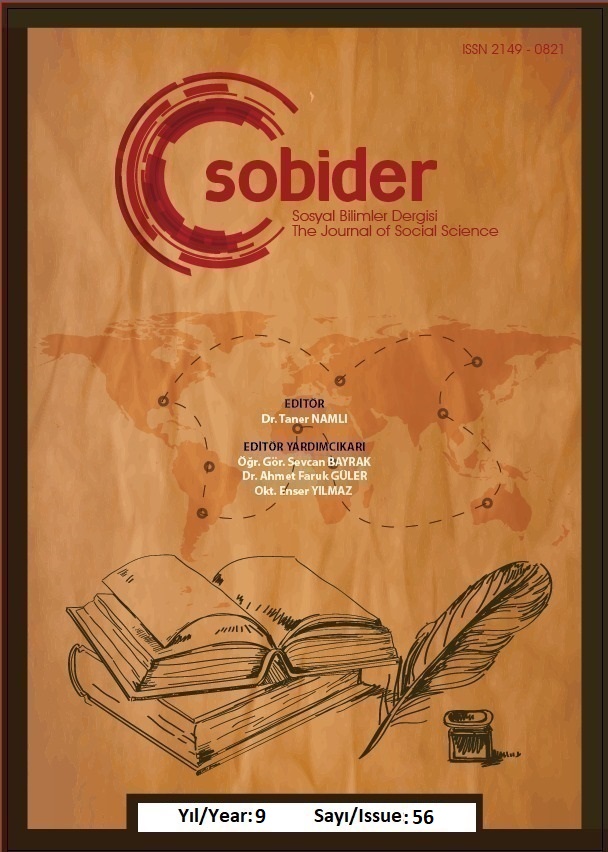Author :
Abstract
Dünya genelinde birçok toplumun sanat anlayışı, yaşadığı coğrafya ve etnik köken ile bağlantılı biçimde oluşmuştur. Bu anlayışın oluşumunda, ilkel çağlardan bu yana yapılan aktarımların etkisi oldukça büyüktür. Kuşaktan kuşağa aktarılarak günümüze ulaşan mitler, söylenceler ve masallar toplumsal belleğin oluşumuna büyük katkı sağlamışlardır. Geçmişe ayna tutan bu anlatılar, hayal ürünü gibi görünseler de dönemlerine ait gerçeklikleri içlerinde barındırmaktadırlar. Fantastik ögelerin görüldüğü bu anlatılar, halen toplumların inanç, kültür ve sanat olgularının bir parçası olmaya devam etmektedirler. Türk toplumları özelinde; mitler, söylenceler ve masallar kültürel kimlik oluşumunun parçası olarak görülmekte ve birçok alanda etkisini hissettirmektedir. Seramik sanatı da bu alanlardan biri olarak ön plana çıkmaktadır. Türkler, bezeme tekniği kullanarak sanatsal amaçla üretilen seramiklerde birçok motif, tasvir ve anlatıya yer vermişlerdir. Özellikle 12 ve 13. yüzyıllarda Büyük Selçuklu Devleti döneminde birçok mit, söylence ve masal unsuru seramik sanatında kendilerine yer bulmuştur. Belirtilen dönemlere ait fantastik anlatıların Türk seramik sanatına yansımaları, bu araştırma ile incelenecektir.
Keywords
Abstract
Most of the societies around the world have formed their understanding of art in a way connected with the geography and ethnic origins in which they live. In the formation of this understanding, the influence of knowledge and experiences transmitted from the earliest times to the present day is of enormous importance. In addition, myths, superstitions and fairy tales produced by society were passed down from generation to generation and provided a social memory formation. Although these narratives, which hold a mirror to the past, seem to be imaginary, they contain the realities of their periods in them. These narratives, in which fantastic elements are seen, still remain part of the beliefs, culture and art phenomena of societies. In Turkish societies, written or oral rumors such as myths, superstitions and fairy tales are seen as part of the formation of cultural identity and have an observable level of influence and importance on society. Ceramic art is one of the fields that reflect this effect in the most observable way. The Turks have included many motifs, descriptions and narratives in the ceramics produced for artistis purposes using the brush decoration technique. Specifically, during the period of the Great Seljuk State in the 12th and 13th centuries, many myths, superstitions and fairy tale elements found their place in ceramic art. The reflections of the fantastic narratives of the specified periods on Turkish ceramic art will be examined with this research.
Keywords
- Bayat, Fuzuli (2016). ‘’Mitolojiye Giriş’’, İstanbul: Ötüken Yayınları.
- Değirmenci, Berfu Ceren (2019) ‘’Mitoloji Ve Anadolu Söylencelerinin Özgün Seramik Form Ve Yüzeylere Yansıması’’ Hacettepe Üniversitesi Güzel Sanatlar Enstitüsü, Seramik Bölümü, Yüksek Lisans Sanat Çalışması Raporu, Ankara.
- Duman, Harun (2019) ‘’Türk Mitolojisinde Ejderha’’. Uluslararası Beşeri Bilimler ve Eğitim Dergisi, Erciyes Üniversitesi Edebiyat Fakültesi II. Dil ve Kültür Çalışmaları Öğrenci Sempozyumu, 482-493 .
- Ertekin, A . (2010) ‘’Fantastik Yazın Nedir?’’ Atatürk Üniversitesi Sosyal Bilimler Enstitüsü Dergisi, 9 (1), 35-46.
- Esin, Emel (2003) ‘’Türklerde Maddi Kültürün Oluşumu’’, Kabalcı Yayınevi, İstanbul.
- Onur Erman, Deniz (2019). ‘’Antik Çağdan Günümüze Seramik Kültürü ve Sanatında Doğurganlık Kavramı. Sanat ve Tasarım Dergisi , (24) , 143-169 .
- Seçkin Sarpkaya (2014) “Türkiye Sahası Efsanelerinde Ejderha”, Yılan Kitabı. Editör: Emine Gürsoy Naskali. İstanbul Kitabevi, ss.505-519.
- Uludağ, Kemal (1998) ‘’Seramik Sanatında Kimlik Sorunu’’, Plastik Sanatlar Dergisi, Sayı: 33
- Zehra Çobanlı (2007) ‘’Anadolu'da Türk Devri Çini ve Seramik Sanatı’’, Kültür ve Turizm Bakanlığı, İstanbul.
- Görsel 3-4: Çobanlı, Zehra.’’ Anadolu'da Türk Devri Çini ve Seramik Sanatı’’, Kültür ve Turizm Bakanlığı, 2007, İstanbul
- Görsel 8: https://nuraybilgili.com/index.php/2021/03/02/turk-kulturunde-kozmik-at-mitolojisi/





